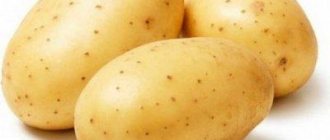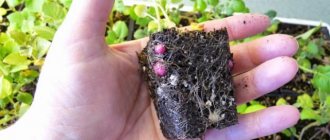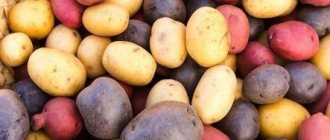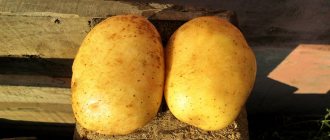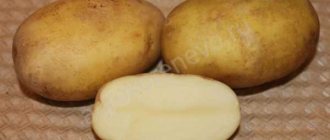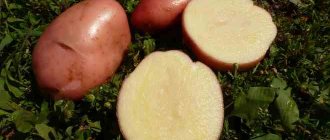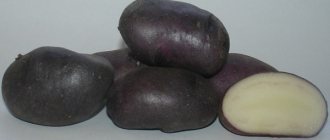Varietal features and characteristics
The bushes are erect, intermediate, tall. The stems are slightly branched, green in color, medium leafy, round in the cross-section area. The corollas of the flowers are white, medium in size, with narrow lobes and developed points. The leaves are medium-sized, medium-dissected, light green in color, with slight pubescence and venation. The roots are oval, smooth, yellow, with few medium-deep eyes. Potato pulp is white and contains about 11.2-18.5% starch. The average weight of the root crop is 105-250 g. Lina potatoes fully ripen in 75-85 days.
Variety value
The popularity of the variety is due to its following positive characteristics:
- high yield, amounting to about 213-496 c/ha;
- high rates of marketability of root crops, reaching 78-99%;
- very good taste and pronounced aroma;
- pronounced late blight resistance;
- the ability to use tubers for the production of potato chips;
- resistance to potato cancer.
The variety is susceptible to damage by the golden potato nematode and requires a full range of preventive and protective measures.
Agricultural technology
Growing Lina potatoes is not difficult due to the unpretentiousness of this variety and its fairly high resistance to adverse external factors. From the very first days of April, you need to start preparing seed tubers for planting. Preparatory work helps accelerate the emergence of friendly shoots, and also allows you to increase the quantity and improve the quality of tubers.
Planting potatoes will be successful if you follow the following recommendations:
- First of all, you need to take into account the geographical zone of cultivation and the type of soil and plant the prepared potato tubers when the soil at a depth of 10 cm warms up well to 6-8 ° C;
- the recommended weight of seed potatoes acceptable for planting varies from 30 to 100 g;
- tubers with signs of disease or deformed are unsuitable for planting;
- soil preparation in the area for potatoes should help ensure favorable thermal conditions and humidity levels;
- liming of the soil for potatoes is carried out a couple of years before planting, since as a result of direct application of lime under the seed material, the tubers are affected by a disease such as scab;
- in the presence of loose soil with a slightly acidic environment (pH 5.6-5),
 potatoes of this variety grow very well and produce a bountiful harvest.
potatoes of this variety grow very well and produce a bountiful harvest.
The planting pattern for seed potatoes is 60 x 35 cm, and the sowing depth should not exceed 8-10 cm. Caring for potatoes consists of maintaining loose soil, systematically destroying weeds and applying fertilizers.
Landing
The site is prepared in advance. In the fall, they plow to a depth of 25-30 cm. At the same time, fertilizers are plowed into the soil - 5-8 kg of compost, 40 g of phosphorus-potassium additive. If the soil is acidified, dolomite, lime, and ash flour are used. In spring, the surface is loosened and additional nitrogen fertilizers are applied.
The holes are dug in an even row or in a checkerboard pattern. The ridges are located from north to south. This way the bushes will be evenly illuminated in the morning and during the day. In sandy loam soils, the holes are made deeper, up to 12 cm, and 5 g of saltpeter is poured into each hole. It is convenient to plant in trenches and furrows on sand, so moisture will be better retained in the ground.
In loams, on dense chernozems, they are planted to a depth of 5-6 cm. To improve aeration, compost, peat, and sand are added to the ground.
Reviews and recommendations
According to reviews from experienced gardeners, growing Lina potatoes is not only very easy, but also economically profitable. The yield is at the level of the very popular Arosa variety, but the appearance of the Lina potato tubers is more marketable and attractive. The variety pleases with a high yield even in rainy summers. Potato pulp is very tasty and does not become overcooked. Berry formation is observed very rarely, and germination when grown from botanical seeds is increased.
Article on the topic: Potato variety “Courage” - description and photo
Growing and care
Agrotechnical techniques are the same as for cultivating other varieties:
- double hilling (with tops length 10-15 cm and 21-26 cm);
- moderate watering until flowering ends;
- fertilizing according to the scheme (during the growing season with nitrogen compounds, then with superphosphate and potassium chloride);
- loosening the surface to a depth of 3-4 cm;
- prevention of diseases and parasites.
The dug crop is ventilated in a shady place for a week. Tubers are sorted for cooking and planting. The potatoes are laid out in boxes and in nets. During the autumn-winter period, storage conditions are maintained at 1-5 degrees.
Description of characteristics
The peel of this variety of root vegetable is yellow, the inside of the potato is white. The fruits are oval in shape with a smooth surface. The number of eyes on the root crop is low. Thanks to this appearance and long shelf life, this variety of potato is valued in the market.
The starch content in the tuber ranges from 11-18%. Potato fruit reaches a weight of up to 250 grams.
The flowering of the potato variety "Lina" is long and quite abundant. Description of flowering period:
- The flowers of the plant are small in size, white in color;
- The tops of the plant are not very branched, straight and tall, and have a light green tint;
- The leaves, like the flowers, are small in size.
After the tops have completely dried, the fruit ripens.
Attention! The fruit ripens on average within 80 days after planting.
Agricultural technology
Landing rules
Varietal potatoes are grown almost throughout Russia and Ukraine. Planting this type of root crop is allowed when the ground warms up by 6-8 degrees at a depth of 10 cm. Typically, the top layer of soil at this depth warms up in late spring, early or mid-May. “Lina” seed potatoes should weigh more than 30 grams, but not more than 100 grams; it is not advisable to use a damaged or spoiled seed tuber. For sowing, identical medium-sized tubers should be selected, since the yield of the root crop depends on the quality of the seeds.
Important! A couple of years before planting the root crop, it is advisable to lim the area where the planting will take place.
The seeds do not need to be buried deeply; the ideal depth is 12 cm, since deep-planted fruits do not produce a good harvest, but are distinguished by abundant tops. If there is a threat of frost, the planted seeds can be earthed up. Hilling should be done when the tops appear.
To get a large harvest, you should know at what distance to plant seeds:
- Row spacing – 60 cm;
- The distance between seeds is 20 cm.
You need to plant in soil rich in nutrients. In order for the yield to be high, it is advisable to plant in the place where they grew:
- Linen;
- Leguminous plants;
- Cereals, especially after wheat;
- And after annual herbs.
Or you can plant varietal potatoes after 2 years of resting the soil, but first it is advisable to saturate the soil with useful substances.
Plant care rules
The plant is unpretentious, but still requires care. Before shoots appear, it is recommended to water the plant as often as possible and loosen the soil. During the first time after planting, if there is a threat of frost, the planted areas must be covered, but the covered layer should not be more than 5 cm. After the seeds sprout, they need to be earthed up; throughout the entire ripening period they should be earthed up 2-3 times. Do not allow an area planted with potatoes to become overgrown with weeds. You can also fertilize the plant from time to time to further increase the yield of the fruit. Drought and frequent rains do not affect the yield of the fruit. But it is advisable not to allow the area to dry out or the percentage of moisture in the ground to exceed if this is caused by unnatural reasons (frequent or infrequent watering).
Article on the topic: Potato variety “Spiridon” - description and photo
Quality irrigation system
Important! Several times during the entire ripening period it is necessary to carry out treatment against pests, especially against Colorado potato beetles. Since every year pests develop immunity to chemicals, if eggs or beetle larvae are detected, re-treatment is required. People who have a negative attitude towards chemicals can use folk remedies to control pests: wood ash, a mixture of mustard and vinegar, cement.
Harvesting
After 80 days have passed after planting, harvesting can begin. It is advisable to carry out cleaning when the ground is dry, this will make it easier to work. Before digging up the fruit, the area should be cleared of grass and tops, but the tops do not need to be cut off completely; the above-ground part should be left, as this has a beneficial effect on the safety of the fruit and from it you can find out the exact location of the tuber. After harvesting, the potato tubers need to be dried. Undried fruits spoil quickly. After which the potatoes can be put into boxes or bags. To preserve presentation, fruits should be transported in boxes. Root vegetables should be stored in a cool room, the temperature in which does not exceed 5 degrees.
Planting and growing potatoes of the Lel variety
Potatoes are an annual crop that is planted immediately in open ground in the spring.
Note! It is recommended to prepare the soil for planting potatoes in the fall.
Preparing for landing
Preparing the soil for planting potatoes includes digging up the area and applying mineral or organic fertilizers. Peat can be used as fertilizer.
An undoubted advantage is the growth of legumes in the area where potatoes are planned to be planted. Before directly planting the tubers, a small amount of calcium is added to the soil.
Soil requirements
Any potato variety grows well in light soils. The normal option is sandy or loamy soil. A bountiful harvest can be obtained by planting potatoes in black soil or peat mixture.
Potato plants will not grow well in clay soil. Such soil needs to be diluted with sand, peat and black soil. It is important that it allows air to pass through well and does not allow water to stagnate, as this can lead to rotting of the tubers.
Dates, scheme and rules of planting
Tubers are planted at the beginning of the 3rd decade of spring. It is important to monitor the temperature and do not plant potatoes if there is a threat of frost or sudden temperature fluctuations. The optimal air temperature is +10°C. In this case, the plant adapts faster and begins to develop.
Advantages and disadvantages of Lina root vegetable
Potatoes "Lana" are a medium early variety characterized by high yield. The main advantages of this type of root crop are the following:
- Suitable for both cooking and production of chips. Due to its marketable appearance, this plant variety is very popular in the market;
- The variety is not susceptible to potato canker and the action of microorganisms that contribute to the development of late blight. However, the golden nematode poses a danger to the plant;
- Differs from many other varieties in good taste;
- Has an excellent presentation;
- Frost resistance, drought resistance;
- In addition, this variety does not require special care.
Disadvantages of the variety:
- High starch content – up to 18%;
- The umbilical part is strongly pressed into the tuber.
One of the highest-yielding types of root crops is “Lina” potatoes. The positive characteristics of this variety were compiled by the best specialists in the field of plant growing; the root crop is resistant to droughts and heavy rains. The peculiarity of the root vegetable is that the plant does not require special care, but has an attractive presentation: a smooth surface with small eyes, an oval shape. All fruits are practically the same size.
LiveInternetLiveInternet
Domestic and foreign practice has established that the use of improved potato seed material helps to increase yields by 4-5 times (and possibly more) compared to ordinary, degenerate material. Unfortunately, potatoes accumulate viral, fungal, bacterial infections and over time lose productivity, i.e. they degenerate. Therefore, as often as possible (at least once every 5 - 7 - 10 years) it is necessary to carry out a variety change to elite seed material. You need to test new varieties, selecting the best for your site. The benefit in this case is obvious, and the costs made for the purchase of high-quality seed material will be justified a hundredfold, because you will receive several times more marketable tubers of excellent quality. We advise you to have at least 3-5 varieties - this will guarantee a harvest in years with different weather conditions. In our variable climate, there is no change from year to year. If during the critical periods of potato life - the first 2-3 weeks after emergence, when the above-ground mass, roots and stolons are actively forming, the weather conditions were favorable and in the beginning of budding-flowering phase, they coincide with the filling of tubers, there was enough moisture in the soil, then a good harvest will not take long to arrive. Any variety reveals its capabilities, including productive potential, in favorable conditions of growth and development. Therefore, wise agronomists, and even amateurs who have a creative approach to solving plant problems, are never limited to one variety.Rosalind
The new German variety has justified ambitions for expansion into the fields of potato growers in Russian regions. It has erect plants, red-violet flowers, oval large pink tubers with creamy flesh. It produces a lot of tubers, up to 15 pieces, and they all reach a weight of at least 100 g by the end of August. Rosalind relies on good agricultural technology and loves watering and fertilizers. Getting a yield of 500 kg per hundred square meters with this variety is not a problem
Bellarosa
A super early, promising variety of German selection, which has just been tested in Russia. The new product is an order of magnitude superior to previously cultivated varieties in terms of disease resistance, starch content, and taste. Thus, very early tuberization (the second ten days of July) helps to avoid late blight damage to both tops and tubers. This variety practically does not require the use of pesticides. The tubers of this variety differ even from others. They are red, large, with very small, superficial eyes, and very, very beautiful. Well, the taste is simply great! "Bellarose" should be on every potato plot.
Vineta
The tuber is oval-round. The peel is yellow. The pulp is light yellow. The weight of the commercial tuber is 67-95 g. The starch content is 12.9-15.2%, the taste is good and excellent. Marketability 87-97%, at the standard level. Keeping quality 87%. Resistant to the pathogen of potato cancer and to the golden potato cyst nematode. Susceptible to the causative agent of late blight on tops, moderately susceptible on tubers. According to the originator, it is resistant to wrinkled and striped mosaic viruses, leaf curl, and tolerates drought well. Value of the variety: nematode resistance, drought resistance, friendly early production, high taste of tubers.
RED FANTASY
A mid-early variety that will not leave any potato grower indifferent. Its highly commercial tubers are beautiful, mostly medium and large in size, elongated oval in shape, with red smooth skin and superficial eyes. The pulp is yellow, has high consumer qualities: tasty, does not darken when cooked. The new variety has high plasticity and is moderately demanding of soil and moisture. The variety is resistant to nematodes and potato cancer, the main dangerous fungal diseases - common scab and late blight of leaves and tubers.
Colette
The tuber is elongated-oval. The peel is yellow. The pulp is light yellow. The weight of the marketable tuber is 66-125 g. The starch content is 12.2-15.2%, 1.5-2.7% lower than the standards of Volzhanin, Bryansk early. The taste is good. Marketability 76-98%, at the standard level. Keeping quality 92%. According to the originator, it is recommended to germinate the tubers before planting. Resistant to potato cancer pathogen and golden potato cyst nematode. According to the All-Russian Research Institute of Phytopathology, it is susceptible to the causative agent of late blight on tops and tubers to isolates isolated in the Moscow and Sakhalin regions. Value of the variety: nematode resistance, early production, evenness of tubers, suitability for processing, good keeping quality of tubers.
LILAC (SUPER NEW!!!!)
For the first time in Russian selection, tubers with PURPLE PULP (for salads, vinaigrettes, etc.) High content of antioxidants! Type of dietary food. Very limited propagation, hence the high price - 1 tuber - 120 rubles.
"ZHUKOVSKY EARLY"
Early ripening: 70-80 days. A flexible variety that produces high yields in various soil and climatic conditions. When planted in the soil, the tubers actively germinate even at low temperatures. Tubers of pink color, leveled, are stored for a long time. One of the best varieties in terms of taste. Drought resistant. Resistant to scab, potato nematode and rhizoctonia.
"WHITE SPRING"
Early ripening: 70-80 days. Table variety with high marketability. The tubers are white, oval, for household needs appear in 55-60 days (become shelf-stable in 70-80 days), good taste. The weight of the commercial tuber is 100-185 g. It is stored well, but is mainly used as fresh early potatoes. Moderately resistant to rhizoctonia and common scab, susceptible to late blight.
"TIMO HANKKIJAN"
Early ripening: 70-80 days. Variety from Finland, table variety, productive, suitable for growing on all types of soil. The tubers are white, round, good taste, and can be stored for a long time. The weight of a marketable tuber is 65-120 g. The shoots are friendly and powerful. The variety is resistant to elevated temperatures, drought and waterlogging. Resistant to rhizoctonia, blackleg, scab, moderately resistant to late blight.
"LUCK"
Early ripening: 70-80 days. A popular high-yielding table variety, suitable for both summer and winter consumption. The tubers are oval, white, with high taste. The weight of a marketable tuber is 90-120 g. The shoots are friendly and powerful: a marketable harvest can be obtained already in June when planted with germinated tubers. The variety is resistant to late blight and blackleg, and is moderately resistant to damage by the Colorado potato beetle.
"SANTE"
Mid-early: 80-90 days. High-yielding Dutch variety of universal use. The tubers are large, oval in shape with yellow skin and light yellow flesh, good taste. It has good marketability and preservation. Suitable for processing into French fries. Resistant to potato nematode, late blight, viruses, moderately resistant to common scab, susceptible to rhizoctonia.
"CONDOR"
Mid-early: 80-90 days. A high-yielding Dutch table variety with high marketability. The tubers are large, elongated oval in shape, with red skin and light yellow flesh. They store well and have excellent taste. The weight of the marketable tuber is 90-180 g. The variety is resistant to viral diseases and common scab, and is susceptible to late blight.
"ROMANO"
Mid-early: 80-90 days. A Dutch table variety with high marketability, enjoying growing popularity. The tubers are round-oval and regular in shape, the skin is pink, strong, not damaged during harvesting, the flesh is light cream, the taste is good. The weight of a marketable tuber is 70-80 g.
"NEVSKY"
Mid-early: 80-90 days. A high-yielding table variety with high marketability and excellent taste. The tubers are round-oval in shape, the skin and pulp are white. The weight of the marketable tuber is 90-130 g. The preservation of the tubers is good. The variety is resistant to rhizoctonia, moderately resistant to late blight, and common scab. Resistant to drought and waterlogging
"FAIRY TALE"
Mid-early: 80-90 days. High-yielding variety with good marketability. The tubers are oval, the peel is yellow, the flesh is white, the preservation is good. The weight of a marketable tuber is 76-129 g. The variety is distinguished by its multi-tuberism: it can produce up to 30 or more potatoes per bush. Resistant to late blight, susceptible to nematodes.
"LUGOVSKOY"
Mid-season: 90-110 days. A high-yielding table variety with high marketability and good taste of the tubers. The tubers are oval in shape, the skin is light pink, the flesh is white, the preservation is good. Weight of marketable tuber is 85-125 g. The variety is resistant to late blight, common scab, moderately resistant to blackleg.
"AGRIA"
Mid-late: 110-120 days. A high-yielding Dutch variety of universal use, suitable for industrial processing. The tubers are elongated-oval, yellow in color, with yellow flesh. High preservation quality. The weight of the marketable tuber is 72-135 g. The variety has high taste qualities. Resistant to potato nematode, susceptible to late blight and common scab.
Description of the potato variety "Lina"
The importance of a crop such as potatoes does not need to be explained to anyone. But we cannot limit ourselves to those varieties that have been used for many decades. Modern Lina potatoes are superior to earlier samples in a number of parameters and deserve close attention.
Related article: Potato variety “Molly” - description and photo
Video about the variety “Lina”
Unfortunately, there is no video for this variety at the moment. We invite you to watch the video section of our website, where other videos about potatoes and other agricultural crops are posted. We and the entire farming community will be grateful if you send us your video or link about this variety from YouTube or any other video hosting service. If you see this message, it means that we have not yet been able to find a suitable video for this variety.
Similar articles:
Potatoes and all their varieties in detail here → Potato variety "Breeze" - description characteristics reviews photo video
Potatoes and all their varieties in detail here → Potato variety "Bettina" - description characteristics reviews photo video
Potatoes and all their varieties in detail here → Potato variety “Bryansk delicacy” - description characteristics reviews photos video
Potatoes and all their varieties in detail here → Potato variety “Borus” - description characteristics reviews photos video
Potatoes and all their varieties in detail here → Potato variety “Snow White” - description characteristics reviews photos video
Peculiarities
This variety belongs to the mid-early group and is well suited as a raw material for making chips. The taste satisfies connoisseurs completely. The tall bush is overgrown with few branching stems with an average concentration of leaves. The leaves themselves have a matte surface, light green in color. The flowering period is long and occurs abundantly.
The tubers are formed in a shape close to an oval, with a smooth yellow skin and white pulp; the weight when reaching commercial ripeness varies from 0.105 to 0.25 kg. The starch concentration ranges from 11.2 to 18.5%, which is slightly lower than the species norm. As for diseases, the situation is as follows:
- potato cancer - not dangerous;
- golden nematode can infect a plant;
- tops and tubers are not susceptible to the action of the studied pathogens of late blight, but we cannot vouch for the unknown mutated microorganisms;
- Sensitivity to ring rot is noted.

